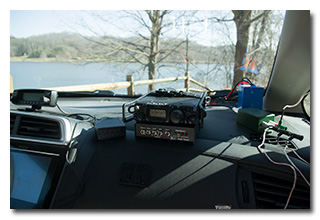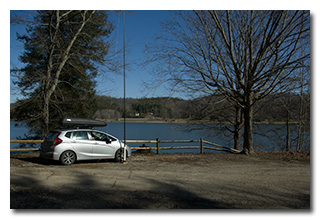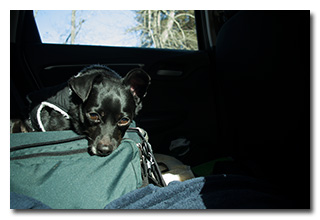Description
 On Saturday, February 11, 2023, two members of the Southeast Ohio Radio Adventure Team
performed a successful activation of Lake Logan State Park in Ohio as part of the Parks on the
Air (POTA; link) program.
On Saturday, February 11, 2023, two members of the Southeast Ohio Radio Adventure Team
performed a successful activation of Lake Logan State Park in Ohio as part of the Parks on the
Air (POTA; link) program.
While on their way to Columbus, Eric McFadden, WD8RIF, and Miles McFadden, KD8KNC, stopped on the west shore of Lake Logan within Lake Logan State Park, arriving at about 1545 UTC. Eric and Miles were accompanied by the little dog Theo. After finding a suitable place to park, Eric and Miles set up the 28½' wire vertical on the Jackite 31' telescoping fiberglass mast and drive-on mount. Because the temperature was just above freezing, Eric chose to operate inside his car, and he set up his Yaesu FT-817ND and LDG Z11 ATU on the passenger-side dashboard. Eric was on the air at 1604 UTC.
 As at his previous activations of this park, Eric had good cell-signal at this location. However, he was
greatly disappointed to again find that his new smartphone had no connection to the internet, so he would
be unable able to spot himself on POTA Spots (link) or to use POTA Spots to
identify possible park-to-park (P2P) QSO opportunities. (Eric suspects his phone's recent update to
Android 12 somehow broke his mobile-data connection and anticipates an hour-long call with TracFone Tech
Support in India to fix the issue.) Fortunately, Eric had previously announced his activation on POTA Spots
so that auto-spotting via the Reverse Beacon Network should spot him once he started calling CQ. Also,
since his phone worked properly, Miles was able to use his phone to verify Eric's spots on POTA Spots.
As at his previous activations of this park, Eric had good cell-signal at this location. However, he was
greatly disappointed to again find that his new smartphone had no connection to the internet, so he would
be unable able to spot himself on POTA Spots (link) or to use POTA Spots to
identify possible park-to-park (P2P) QSO opportunities. (Eric suspects his phone's recent update to
Android 12 somehow broke his mobile-data connection and anticipates an hour-long call with TracFone Tech
Support in India to fix the issue.) Fortunately, Eric had previously announced his activation on POTA Spots
so that auto-spotting via the Reverse Beacon Network should spot him once he started calling CQ. Also,
since his phone worked properly, Miles was able to use his phone to verify Eric's spots on POTA Spots.
Since the Solar Flux Index had risen above 200, Eric had hoped to perform a 15m-only activation. Finding himself a frequency on 15m to run, Eric began calling CQ, and was pleased when Miles told him he had been auto-spotted on POTA Spots. Eric's first QSO came at 1607 UTC with KJ7DT in Idaho. Eric's second QSO came at 1609 UTC with AB0BM in Iowa. Continual calling failed to produce any additional QSOs and, recognizing that 15m wasn't going be productive, Eric changed to 20m at 1613 UTC.
 Finding himself a frequency to run on 20m, Eric began calling CQ, and was again auto-spotted on POTA
Spots. His first QSO in this run came at 1616 UTC with VE3DQN in Ontario. QSOs came quickly on 20m,
with Eric's thirteenth QSO in this run coming at 1630 UTC with stalwart POTA Hunter K9IS in Wisconsin.
This run included a P2P QSO with W9FHA who was activating Gulf Islands National Seashore (K-0661) in
Florida and QSOs with operators located in Ontaria, New York (2), Michigan, North Carolina (2),
Florida (2), Tennessee (2), Louisiana, Oklahoma, and Wisconsin.
Finding himself a frequency to run on 20m, Eric began calling CQ, and was again auto-spotted on POTA
Spots. His first QSO in this run came at 1616 UTC with VE3DQN in Ontario. QSOs came quickly on 20m,
with Eric's thirteenth QSO in this run coming at 1630 UTC with stalwart POTA Hunter K9IS in Wisconsin.
This run included a P2P QSO with W9FHA who was activating Gulf Islands National Seashore (K-0661) in
Florida and QSOs with operators located in Ontaria, New York (2), Michigan, North Carolina (2),
Florida (2), Tennessee (2), Louisiana, Oklahoma, and Wisconsin.
In all, Eric made fifteen QSOs, including one P2P QSO, in just under half an hour of on-air time. All of Eric's QSOs were CW and were made with five watts output.
Eric was pleased with how well the FT-817ND/Z11 combination worked although he found that his small and lightweight American Morse Equipment Mini-B single-lever was hard to hold while keying. Eric will look into either a heavier base for the key, or will some rubber feet to the current lightweight base.
Miles did not operate but helped with set-up and tear-down and did most of the activation photography.
Eric also submitted his log to the World Wide Flora and Fauna in Amateur Radio (WWFF; link) program.
(return)
